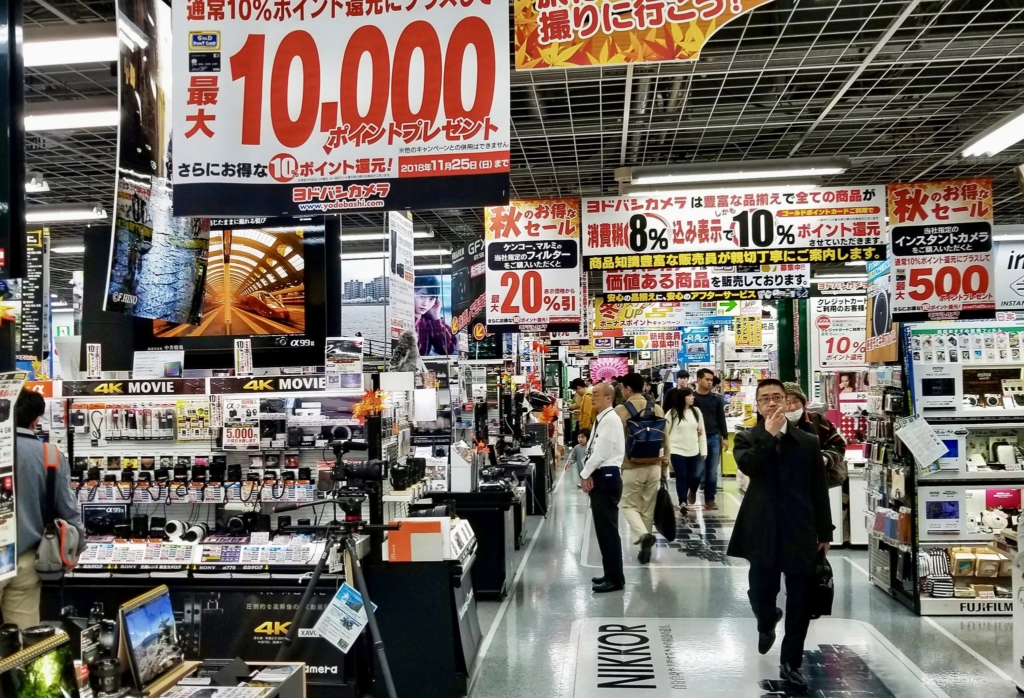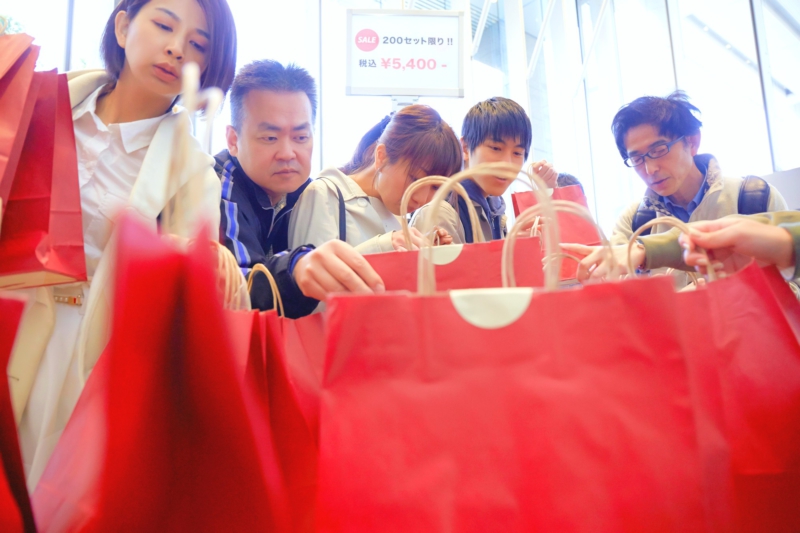There’s nothing more bitter than noticing a major sale for something you just recently bought at full price! If you’re looking to splurge on a major purchase, like Japanese designer goods or home appliances, you should make sure you time it properly. Thankfully, there is a relatively predictable annual schedule of sales for various products, and this article will go through it all!
Update: You can also save money with coupons for Japanese electronics stores BicCamera, YAMADA DENKI, and EDION.
Japan’s Biggest Sales Period: “Hatsu-uri”
The short, simple answer to “when should I wait for the biggest sales in Japan” is the period between December and early February. This is the time of year when you can most surely find a discount in most department stores, making it the Japanese equivalent of Black Friday in the US. The sales period is typically broken into three phases: there is sometimes a presale for a few days in December, reserved to loyal customers, before a general sale beginning in January, usually starting on the 2nd and lasting at least two weeks. Some stores offer a later clearance sale that amps up the discounts even more, but beware: many items will have sold out by this point! Within the fashion industry, some 90% of items are on sale in the first week, with discounts often starting at 30%, ramping up to 50% later on.

This sales period is referred to by a particular name—hatsu-uri (初売り), or first sale of the year—and it is a whole affair: beyond just offering discounts on existing items, malls can offer limited-edition product lines and in-person events to stir up interest. There are also “time sales”, or particularly large discounts at particular hours of certain days. Big-box stores and online retailers join the fun as well. In the particular case of e-commerce, the sales season begins earlier, with Cyber Monday in early December, although discounts are generally modest. Outlet malls, meanwhile, tend to offer sales later, in the second half of January.
The upshot: Wander into basically any store in the first half of January, and you can bet there will be a sale! The earlier you go, the fuller the inventory, but the crowds will be larger as well. (If there’s a store you really love, you can participate in the time-honored Japanese tradition of lining up outside the store before it opens.) Stores will have all sorts of different special promotions and limited-edition items, but they won’t be subtle in promoting them, so there’s little chance of missing out if you stay aware!
This article answers the question of “when” to go shopping, but this still leaves the question of “what” you can buy in Japan during sales periods. Our sister site Tsunagu Japan has a considerable list of shopping articles to give you inspiration!
A Special Feature of the Hatsu-uri Sales: Mystery Grab Bags (“Fukubukuro”)

While you’re on your beginning-of-year shopping spree, you should look out for “fukubukuro” (福袋; “lucky bags”), which are bags filled with a variety of in-store items. In general you don’t know what’s inside the bags until after you buy them, and in return for that, prices are extremely low! The discounts are of course a positive, but for some, there’s also the thrill of buying a mystery bag and waiting to get home before opening it.
3000-7000 yen is a reasonable expectation for these bags, although many bags exceed this range on either side. It’s become common for stores to allow you to reserve bags in advance—usually in early December but as early as October—to save you the hassle of lining up on the day of. Particularly in-demand fukubukuro (like Starbucks’) might even allocate the bags by lottery! Fukubukuro are such a broad cultural phenomenon that all kinds of stores jump on the bandwagon, from fashion to teahouses to electronics stores to e-commerce sites (which mail you the bags rather than making you pick them up).
The upshot: Pre-ordering these bags, where available, is an excellent way to score a sweet New Year’s deal without dealing with the crowds. You should keep your eyes peeled for announcements as early as November, and subscribing to your favorite brands’ mailing lists is helpful too!
Early July: The Best Time for Spring and Summer Items

Much like year-end sales help stores clear out their winter items before releasing their spring collections, mid-summer sales function as clearance sales for spring and summer items. This period, between early July and early August, is the other major annual period of sales in Japan.
This isn’t as broad a cultural phenomenon as the winter sale, although within the fashion industry, some 90% of items are on sale. The schedule is more diffuse, with each brand and department store setting its own beginning and end dates. The first half of July is when most of these sales overlap, although others schedule theirs for later in the month (including Roppongi Hills and Tokyo Solamachi). You can find discounts of 30-40% for summer items, and even 50% for spring clothing. You will have to check your favorite stores individually, but so long as you verify in early July, there’s no risk of having already missed out. Outlet malls, meanwhile, move at their own pace here as well; their major summer sales tend to be a full month later than department stores’, in late August.
For Appliances, A Different Sales Schedule
While, as mentioned above, electronics and appliances have very much jumped on the beginning-of-year-sale bandwagon, the most significant sales timeline is different. The biggest sales of the year are the “kessan” (決算, “balance sheet”) sales, where companies do everything they can to boost sales before filing their official financial reports. One such sale is in August and September, in advance of the mid-term report, but the biggest sale is in February and March, in advance of the year-end report. (Japan’s fiscal year ends in March.)

Most companies hold their kessan sales in March and September, including the country’s four largest electronics stores (Yamada, Yodobashi, Edion, and K’s), while Bic Camera holds theirs in February and August. Always check the precise sales period in advance and go early, to guarantee your preferred model hasn’t sold out.

Another possibly helpful tip is that when new appliance models are released, older models see great discounts in order to get rid of inventory. (This is analogous to fashion stores’ clearance sales.) However, the times vary significantly—February and August for TVs, September for refrigerators, March for air-conditioners but October for upscale air-conditioners, and so on. If there’s a particular product you have your eye on, you could look on Amazon to see the date it was released and get a sense of the annual release schedule. Machines should be on sale the month before the new version comes out. If you prefer looking at various models and comparing their specs and prices on the spot, however, remember the kessan sale of February and March.
Incidentally, the kessan sale period often coincides with “shinseikatsu” (新生活) sales. The term, meaning “new living”, refers to how April is a month of new school years and new careers. You can find great deals for appliances, as well as business-related items like suits and stationery, under this type of sale, so keep your eye out for them as well!
Seeking out sales periods is a solid way of getting discounts, but it’s not the only way! Here, Tsunagu Japan presents 7 more ways to save when shopping in Japan.

Does Japan Have Black Friday Sales?
Japan has Black Friday sales too! Black Friday may not be the year-defining bonanza that it is in the United States, but it is slowly taking root in Japan, with superstore chain AEON being an early adopter. Big-box stores Bic Camera and Nojima have also jumped on the Black Friday trend, while e-retailers Amazon and Rakuten have begun their own Black Friday traditions as well.
If you really can’t wait to make your purchase, there are smaller sales scattered throughout the year. As in other countries, Halloween and Valentine’s Day are associated with promotions, as is the baseball championship series in October, when the winning team’s sponsoring company celebrates with discounts. In addition, Golden Week (late April – early May) sees the occasional sale, including brands like MUJI and UNIQLO as well as outlet malls.
A Bit of Preparation Can Get You Big Discounts!
Hopefully this article has presented all you need to know about sales in Japan: early January is the focal point, one that is worth researching and preparing in advance for. Aside from that, July offers solid discounts at department stores and February or March are best for appliances.
If you want to give feedback on any of our articles, you have an idea that you’d really like to see come to life, or you just have a question on Japan, hit us up on our Facebook!
The information in this article is accurate at the time of publication.

